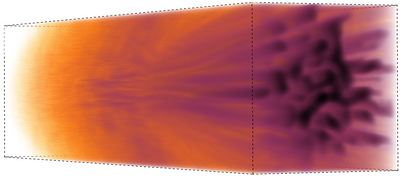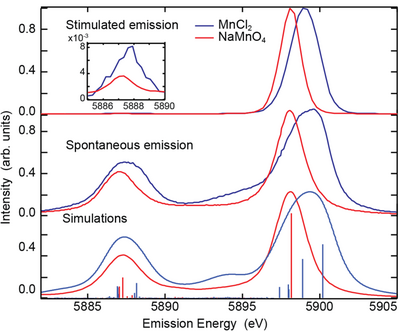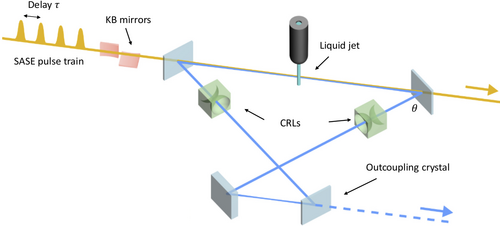Inner-shell x-ray lasing
Construction of an x-ray laser was a dream starting from the 1960-s. Starting from 2010-s, XFEL facilities provide x-ray pulses that are short and intense, but the inherent randomness (due to the noise amplification concept of XFELs) results in poor stability and low longitudinal coherence. The XFEL pulse can be used as a pump for inner-shell transition, e.g. to create a hole in the 1s shell and in this way produce population inversion between 2p and 1s shells, thus leading to laser-like amplification of the x-ray fluorescent radiation. This was demonstrated in the pioneering experiment by Nina Rohringer in 2011, where the exponential amplification of Ne K-alpha fluorescent radiation in the forward direction was convincingly observed. In a series of subsequent papers, the inner-shell x-ray lasing – in some cases up to in saturation – was demonstrated from gas, liquid, and solid media. In our group, we are investigating the inner-shell x-ray lasing phenomenon from three perspectives: developing theoretical formalism for detailed quantitative description, applying as a nonlinear x-ray emission spectroscopy technique, and applying as a source of x-ray radiation with unique properties.
Theoretical modeling

Calculated field amplification out of spontaneous emission noise
The quantitative description of radiation from core-ionized matter is challenging. In general, it should self-consistently combine the description of: 3D electromagnetic field propagation, filed-driven nonperturbative atomic transitions (like Rabi flopping), and quantum field fluctuations causing spontaneous emission (that triggers the amplification process). Our current approach under development is based on numerical modeling of stochastic differential equations that were derived starting from the full quantized treatment of the field and atomic transitions.
Stimulated x-ray emission spectroscopy

K-alpha x-ray emission spectra of Mn in two oxidation states measured in stimulated emission case (upper panel), in traditional case (middle panel) and theoretically simulated for traditional case (lower panel). In spite of alternated spectral profile, the chemical shift is preserved in the stimulated case. From Kroll et al., PRL 120, 133203 (2018)
The spectrum of inner-shell x-ray lasing radiation can be considered as a strongly and nonlinearly amplified x-ray emission spectrum. The strong amplification in the forward direction (along the pump-pule propagation) dramatically increases the signal-to-noise ratio but also modifies the spectral shape due to nonlinear effects. It was experimentally proven that spectroscopic information, e.g. chemical shift, is preserved in the spectra. The nonlinearity and saturation challenge the theoretical interpretation, but also provide opportunities for narrowing the lineshape. Another direction (put forward by the group of Uwe Bergmann) is the usage of two-color XFEL pulses – to put the sample in amplifying state by one color and to seed the transition of interest (e.g., K-beta that is more susceptible to the chemical environment) with the other color.
X-ray laser oscillator
Up to now, all experiments on inner-shell x-ray lasing were performed in a single-pass amplification regime that starts from random spontaneous emission. Thus, the radiation characteristics have pulse-to-pulse variation due to the randomness of the pump and radiation process itself. The introduction of a cavity could pave the way towards stable and highly coherent pulses – only radiation in a narrow spectral-angular range could propagate within the cavity. With the XFEL pump in a form of a pulse train (with inter-pulse distance adjusted to cavity length), all pulses in the train would contribute to the narrow cavity-conditioned x-ray field, thus ensuring stability, power, and brightness.

Scheme of x-ray laser oscillator: XFEL pump pulse (yellow) is focused onto liquid jet, where the amplified spontaneous emission is generated (blue). The emitted radiation is Bragg-diffracted from crystals and is returned to the liquid jet where it serves as a seed pulse, at the same time the next pump pulse of the train arrives (distance between pump pulses is shown not to scale). From Halvanau et al., PNAS 117, 15511-15516 (2020)
Involved group members:
Main collaborators:
SLAC, Stanford, USA
Uwe Bergmann, Claudio Pellegrini, Alex Halavanau, Thomas Kroll
Universität Hamburg, Germany
Matthias Trabs
Jožef Stefan Institute, Ljubljana, Slovenia
Matjaž Žitnik, Špela Krušič